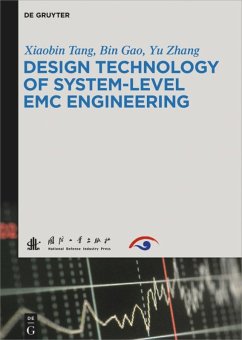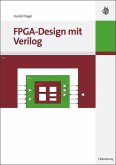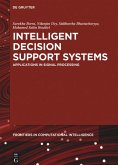This book introduces the state-of-the-art research progress of system-level EMC, including theories, design technologies, principles and applications in practice. The engineering design, simulation, prediction, analysis, test, stage control as well as effectiveness evaluation are discussed in detail with extensive project experiences, making the book an essential reference for researchers and industrial engineers.
Table of Contents
Chapter 1 Introduction and Preview
1.1 Introduction
1.2 Design technologies of system-level EMC engineering
1.2.1 Application demands of system-level EMC technology engineering
1.2.2 Research focus of design technology of system-level EMC engineering
1.3 Design flow of system-level EMC engineering
1.4 Standards related to system-level EMC engineering design
Reference
Chapter 2 Theoryof system-level EMC
2.1 Basic concept
2.2 Electromagnetic interference sources
2.2.1 Conditions of EMI
2.2.2 Types of EMI sources
2.3 Theory of transmission and coupling of EM energy
2.3.1 Path of EMI Coupling
2.3.2 Basic theory of conduction coupling
2.3.3 Basic theory of radiation coupling
2.4 Characteristic of EM sensitivity sources
2.4.1 Channel model of receiver
2.4.2 Blockage, crossover distortion and intermodulation of receiver
2.5 Examples of the application of EMC theory
Reference
Chapter 3 Engineering design of system-level EMC
3.1 Design method
3.2 Design principles
3.3 Design flow
3.3.1 Comfirmation of boundary condition
3.3.2 Predictive analysis
3.3.3 Multi-level design
3.4 Content of design
3.4.1 Design for controlling the EM emission and Sensitivity of equipment/sub-system
3.4.2 Design for controlling inter-antenna interference
3.4.3 Design for controlling inter-cable intereference
3.4.4 Design for EM radiation protection
3.4.5 Design of lapping and grounding
3.4.6 Design for lightning protection
3.4.7 Design for electrostatic protection
3.4.8 Design of power supply
3.5 Examples of Engineering design
Reference
Chapter 4 Theory and method of system-level EM simulation
4.1 EM simulation methods
4.1.1 Frequency-domain method
4.1.2 Time-domain method
4.1.3 High-frequency algorithm
4.1.4 High-low Frequency Hybrid Algorithm
4.1.5 Parallel computing for EM simulation
4.2 Examples of airborne antenna system-level EMC simulation
4.2.1 Radiation and coupling of airborne monopole antenna
4.2.2 Radiation of airborne microstrip phased array antenna
4.2.3 Radiation of waveguide slots phased array antenna on metal slab
4.2.4 Radiation of airborne waveguide slots phased array antenna
4.3 Summary
Reference
Chapter5 Analysis of system-level EMC prediction
5.1 Theory of system-level EMC prediction
5.1.1 Equation of System-level EMC prediction
5.1.2 Transmitter model
5.1.3 Receiver model
5.1.4 Antenna model
5.1.5 Transmission model
5.2 Strategy of system-level EMC prediction
5.2.1 Step of system-level EMC prediction
5.2.2 Method of system-level EMC prediction
5.3 Introduction of EMC prediction softwares
5.3.1 Domestic and international EMC Prediction softwares
5.3.2 EMC softwares for Airborne platform
5.4 Examples of System-level EMC prediction
Reference
Chapter6 Experiment and assessment of system-level EMC
6.1 EMC tests and experiment system frame
6.2 System-level EMC tests and experiment contents
6.2.1 Equipment-level/LRU-level EMC experiment
6.2.2 Sub-system/Rack-level EMC experiment
6.2.3 Whole-system EMC experiment
6.2.4 Verification tests of EM environment adaptability
6.2.5 Test results and report details of system-level EMC experiment
6.3 Experimental facility and test field of EMC
6.3.1 Open area test field
6.3.2 Semi-anechoic chamber
6.3.3 Reverberation chamber
6.3.4 TEM chamber
6.3.5 GTEM chamber
6.3.6 Shielded room
6.4 Evaluation method of system-level EMC experiment
6.4.1 Experiment method of EMI emission and EM sensitivity
6.4.2 Experiment method of system-level EMC
6.4.3 Evaluation method of system-level EMC
6.5 Typical evaluation platform for EMC experiment and Examples of their application
6.5.1 Equipment-level and subsystem-level EMC varification system
6.5.2 Monitoring System of EM environment and EM spectrum
6.5.3 System of HPM excitation for EM environment
6.5.4 Verification and evaluation system for EM environmental effects
Reference
Chapter7 Stage control of System-level EMC
7.1 Stage Control technology of spatial EMC
7.1.1 Basic concept of spatial EMC control
7.1.2 Design flow of spatial EMC control
7.2 Stage Control technology of frequency-domain EMC
7.2.1 Basic concept of frequency-domain distribution EMC
7.2.2 Design flow of freqency management
7.3 Stage Control technology of energy-domain EMC
7.3.1 Basic concept of filtering
7.3.2 Design flow of filtering
7.4 Stage Control technology of time-domain EMC
7.4.1 Basic concept of time-domain EMC control
7.4.2 Design flow of time-domain EMC control
7.5 Application Examples of System-level EMC control
Reference
Chapter8 Applications in engineering projects and progress in new technologies
8.1 Design of system-level EMC
8.1.1 Basic status of system-level EM environment
8.1.2 Design of system-level EM environment
8.2 Simulation of EMC prediction
8.2.1 Analysis of EMC prediction
8.2.2 Simulation of EMC prediction
8.3 System-level EMC testing
8.3.1 Equipment-level / subsystem-level EMC testing
8.3.2 System-level EMC testing
8.4 System-level EMC control
8.4.1 Design control
8.4.2 Testing control
8.5 System-level EMC Evaluation
8.6 EMC new technologies and progress
8.6.1 Comprehensive design technology
8.6.2 New Simulation prediction technology
8.6.3 New Technology of measurement
8.6.4 New Technology of EM spectrum control
Reference
Chapter 1 Introduction and Preview
1.1 Introduction
1.2 Design technologies of system-level EMC engineering
1.2.1 Application demands of system-level EMC technology engineering
1.2.2 Research focus of design technology of system-level EMC engineering
1.3 Design flow of system-level EMC engineering
1.4 Standards related to system-level EMC engineering design
Reference
Chapter 2 Theoryof system-level EMC
2.1 Basic concept
2.2 Electromagnetic interference sources
2.2.1 Conditions of EMI
2.2.2 Types of EMI sources
2.3 Theory of transmission and coupling of EM energy
2.3.1 Path of EMI Coupling
2.3.2 Basic theory of conduction coupling
2.3.3 Basic theory of radiation coupling
2.4 Characteristic of EM sensitivity sources
2.4.1 Channel model of receiver
2.4.2 Blockage, crossover distortion and intermodulation of receiver
2.5 Examples of the application of EMC theory
Reference
Chapter 3 Engineering design of system-level EMC
3.1 Design method
3.2 Design principles
3.3 Design flow
3.3.1 Comfirmation of boundary condition
3.3.2 Predictive analysis
3.3.3 Multi-level design
3.4 Content of design
3.4.1 Design for controlling the EM emission and Sensitivity of equipment/sub-system
3.4.2 Design for controlling inter-antenna interference
3.4.3 Design for controlling inter-cable intereference
3.4.4 Design for EM radiation protection
3.4.5 Design of lapping and grounding
3.4.6 Design for lightning protection
3.4.7 Design for electrostatic protection
3.4.8 Design of power supply
3.5 Examples of Engineering design
Reference
Chapter 4 Theory and method of system-level EM simulation
4.1 EM simulation methods
4.1.1 Frequency-domain method
4.1.2 Time-domain method
4.1.3 High-frequency algorithm
4.1.4 High-low Frequency Hybrid Algorithm
4.1.5 Parallel computing for EM simulation
4.2 Examples of airborne antenna system-level EMC simulation
4.2.1 Radiation and coupling of airborne monopole antenna
4.2.2 Radiation of airborne microstrip phased array antenna
4.2.3 Radiation of waveguide slots phased array antenna on metal slab
4.2.4 Radiation of airborne waveguide slots phased array antenna
4.3 Summary
Reference
Chapter5 Analysis of system-level EMC prediction
5.1 Theory of system-level EMC prediction
5.1.1 Equation of System-level EMC prediction
5.1.2 Transmitter model
5.1.3 Receiver model
5.1.4 Antenna model
5.1.5 Transmission model
5.2 Strategy of system-level EMC prediction
5.2.1 Step of system-level EMC prediction
5.2.2 Method of system-level EMC prediction
5.3 Introduction of EMC prediction softwares
5.3.1 Domestic and international EMC Prediction softwares
5.3.2 EMC softwares for Airborne platform
5.4 Examples of System-level EMC prediction
Reference
Chapter6 Experiment and assessment of system-level EMC
6.1 EMC tests and experiment system frame
6.2 System-level EMC tests and experiment contents
6.2.1 Equipment-level/LRU-level EMC experiment
6.2.2 Sub-system/Rack-level EMC experiment
6.2.3 Whole-system EMC experiment
6.2.4 Verification tests of EM environment adaptability
6.2.5 Test results and report details of system-level EMC experiment
6.3 Experimental facility and test field of EMC
6.3.1 Open area test field
6.3.2 Semi-anechoic chamber
6.3.3 Reverberation chamber
6.3.4 TEM chamber
6.3.5 GTEM chamber
6.3.6 Shielded room
6.4 Evaluation method of system-level EMC experiment
6.4.1 Experiment method of EMI emission and EM sensitivity
6.4.2 Experiment method of system-level EMC
6.4.3 Evaluation method of system-level EMC
6.5 Typical evaluation platform for EMC experiment and Examples of their application
6.5.1 Equipment-level and subsystem-level EMC varification system
6.5.2 Monitoring System of EM environment and EM spectrum
6.5.3 System of HPM excitation for EM environment
6.5.4 Verification and evaluation system for EM environmental effects
Reference
Chapter7 Stage control of System-level EMC
7.1 Stage Control technology of spatial EMC
7.1.1 Basic concept of spatial EMC control
7.1.2 Design flow of spatial EMC control
7.2 Stage Control technology of frequency-domain EMC
7.2.1 Basic concept of frequency-domain distribution EMC
7.2.2 Design flow of freqency management
7.3 Stage Control technology of energy-domain EMC
7.3.1 Basic concept of filtering
7.3.2 Design flow of filtering
7.4 Stage Control technology of time-domain EMC
7.4.1 Basic concept of time-domain EMC control
7.4.2 Design flow of time-domain EMC control
7.5 Application Examples of System-level EMC control
Reference
Chapter8 Applications in engineering projects and progress in new technologies
8.1 Design of system-level EMC
8.1.1 Basic status of system-level EM environment
8.1.2 Design of system-level EM environment
8.2 Simulation of EMC prediction
8.2.1 Analysis of EMC prediction
8.2.2 Simulation of EMC prediction
8.3 System-level EMC testing
8.3.1 Equipment-level / subsystem-level EMC testing
8.3.2 System-level EMC testing
8.4 System-level EMC control
8.4.1 Design control
8.4.2 Testing control
8.5 System-level EMC Evaluation
8.6 EMC new technologies and progress
8.6.1 Comprehensive design technology
8.6.2 New Simulation prediction technology
8.6.3 New Technology of measurement
8.6.4 New Technology of EM spectrum control
Reference








